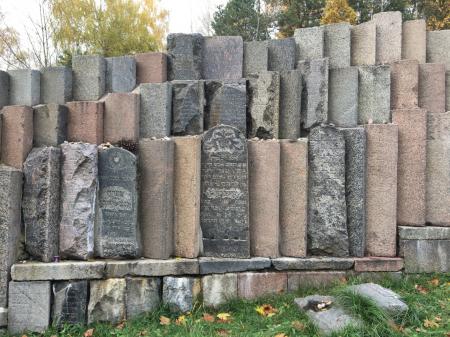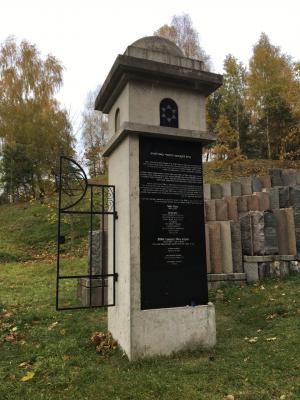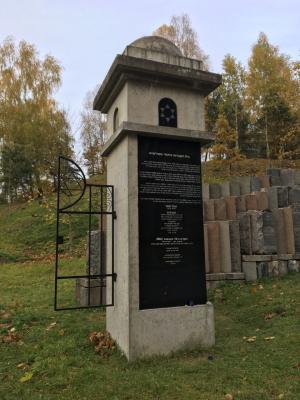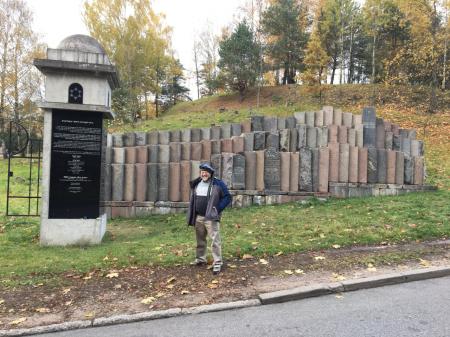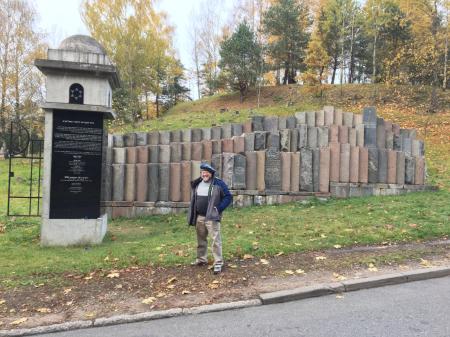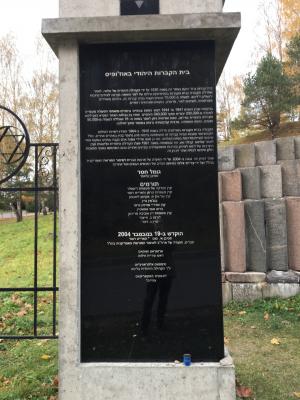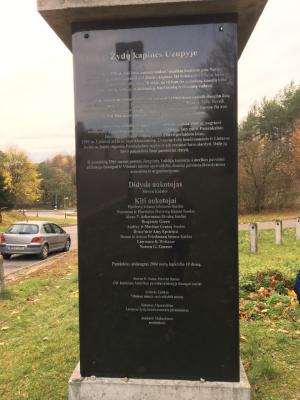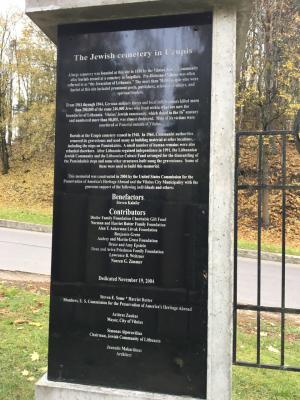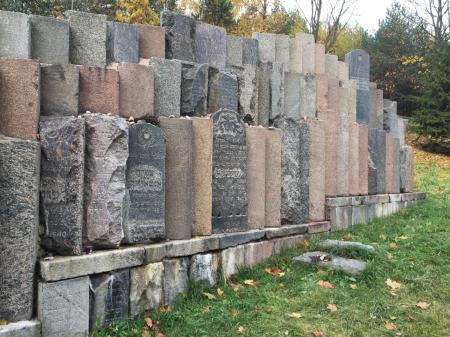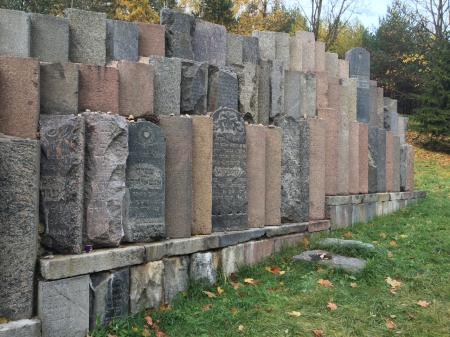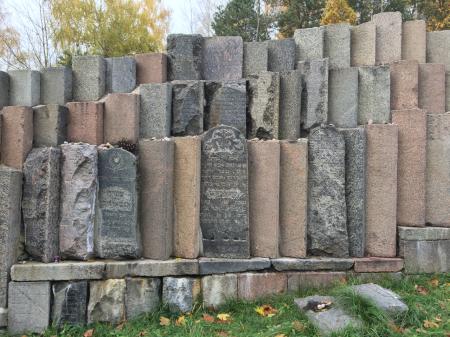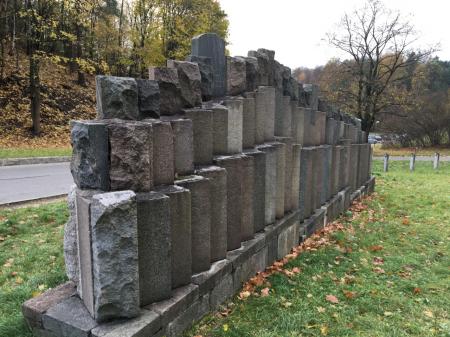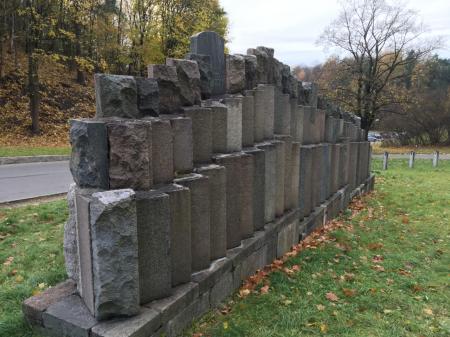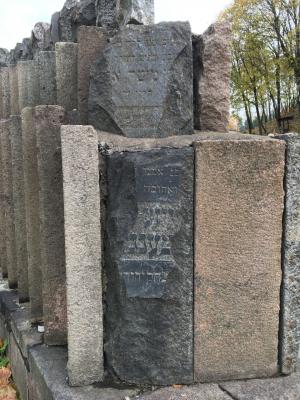Obj. ID: 45479
Memorials Memorial at the Site of the Second (Užupis) Jewish cemetery in Vilnius, Lithuania, 2004
To the main object: Site of the Second (Užupis) Jewish cemetery in Vilnius, Lithuania

What is Commemorated?
The Second Jewish Cemetery in Vilnius, destroyed in 1964. The inscription on the memorial describes the Holocaust in Lithuania and in Vilnius.
Description:
The monument consists of two parts:
A concrete pillar with a dome echoes the gates of the Užupis cemetery as seen in old photographs. The original gate was probably designed by architect A. Viner. Black marble plaques with identical inscriptions in Hebrew, Lithuanian, and English are attached to the pillar.
Behind this “gate” and slightly up a hillside is a large monument that is an assemblage of approximately 75 similarly sized gravestones. These stones were retrieved from the Tauras Hill steps which accounts for their being cut and shaped to a uniform size. There is a foundation made of gravestones, and on top of these are three rows of erect stones, each row set slightly back from and higher than the other, and all the stones erected and joined in an overlapping pattern that creates a continuous wall. Whenever possible the stones have been placed with their funerary inscriptions facing out so they can be read. However, only faint inscriptions are visible on many of them, as these were cut and refinished into uniform blocks as part of their re-purposing, and subsequently suffered decades of exposure and wear.
Inscriptions:
On the northern side, in English:
The Jewish cemetery in Uzupis
A large cemetery was founded at this site in 1830 by the Vilnius Jewish Community
after burials ceased at a cemetery in Šnipiškis. Pre-Holocaust Vilnius was often
referred to as “the Jerusalem of Lithuania.” The more than 70,000 people who were
buried at this site included prominent poets, publishers, scientists, bankers, and
spiritual leaders.
From 1941 through 1944, German military forces and local collaborators killed more
then 200,000 of the some 240,000 Jews who lived within what are now the
boundaries of Lithuania. Vilnius’ Jewish community, which dated to the 16th century
and numbered more than 50,000, was almost destroyed. Most of its victims were
murdered at Paneriai outside of Vilnius.
Burials at the Uzupis cemetery ceased in 1948. In 1964, Communist authorities
removed its gravestones and used many as building material at other locations,
including the steps on Pamėnkalnis. A small number of human remains were also
reburied elsewhere. After Lithuania regained independence in 1991, the Lithuanian
Jewish Community and the Lithuanian Culture Fund arranged for the dismantling of
the Pamėnkalnis steps and some other structures built using the gravestones. Some of
these were used to build this memorial.
This memorial was constructed in 2004 by the United States Commission for the
Preservation of America’s Heritage Abroad and the Vilnius City Municipality with the
generous support of the following individuals and others:
Benefactors
Steven Kalafer
Contributors
Distler Family Foundation Charitable Gift Fund
Norman and Harriet Rotter Family Foundation
Alan T. Ackerman Litvak Foundation
Benjamin Green
Audrey and Martin Gruss Foundation
Bruce and Amy Epstein
Dean and Aviva Friedman Family Foundation
Lawrence B. Weitzner
Noreen G. Zimmer
Dedicated November 19, 2004
Steven E. Some * Harriet Rotter
Members, U.S. Commission for the Preservation of America’s Heritage Abroad
Artūras Zuokas
Mayor, City of Vilnius
Simonas Alperavičius
Chairman, Jewish Community of Lithuania
Jaunutis Makariūnas
Architect
On the southern side, in Hebrew:
בית הקברות היהודי באוז'ופיס
בית קברות גדול הוקם באתר זה בשנת 1830 על ידי הקהילה היהודית של ווילנה, לאחר
שחדלה הקבורה בבית הקברות בשניפישקס. ווילנה של לפני השואה נקראה לעיתים קרובות
ירושלים ד'ליטא. למעלה מ-70,000 אנשים נקברו נקברו בבית קברות זה, ביניהם משוררים
מפורסמים, מוציאים לאור, מדענים, בנקאים ומנהיגים רוחניים.
בתקופה שבין השנים 1941 עד 1944 רצחו כוחות צבאיים גרמניים ומשתפי הפעולה מקומיים
למעלה מ-200,000 יהודים מתוך 240,000 היהודים שחיו בין גבולות האזור הנקרא כיום ליטא.
הקהילה היהודית בווילנה, שאת שורשיה ניתן לאתר במאה ה-16 ושכללה למעלה מ-50,000
אנשים, כמעט הושמדה. מרבית קורבנותיה נרצחו בפונאר מחוץ לווילנה.
הקבורה בבית הקברות באוז'ופיס חדלה בשנת 1948. ב-1964 הסירו רשויות השלטון
הקומוניסטי מצבות מבית קברות זה והשתמשו ברבות מהן כחומר בניין באתרים אחרים, כולל
שימוש לבניית מדרגות בפאמנקאלניס. כמו כן מעט שריגי גופות אדם נקברו מחדש במקום אחר.
לאחר שליטא קבלה שוב את עצמאותה בשנת 1991 פעלו הקהילה היהודית הליטאית וקרן
התרבות של ליטא לפירוק מדרגות פאמנקאלניס ובניינים אחרים בהם השתמשו באבני המצבות.
חלקן שימשו לבניית אתר זיכרון זה.
אתר זיכרון זה נבנה ב-2004 על ידי הוועדה של ארצות הברית לשימור המושרת האמריקנית
בחו"ל ועל ידי עיריית ווילנה בסיועם הנדיב של האנשים הבאים ושל אחרים:
גומל חסד
סטיבן קלאפר
תורמים
קרן הצדקה של משפחת דיסטלר
קרן משפחת נורמן והארייט רוטר
קרן של אלן ת. אקרמן ליטבאק
בנג'מין גרין
קרן אודריי ומרטין גרוס
ברוס ואני אפשטיין
קרן משפית דין אביבה פרידמן
לורנס ב. ווייצנר
נורין ג. זימר
הוקדש ב-19 בנובמבר 2004
סטיבן אי. סום * הארייט רוטר
חברים, הוועדה של ארה"ב לשימור המורשת האמריקנית בחו"ל
ארטוראס זואקאס
ראש עיריית ווילנה
סימןנאס אלפראוויצ'יוס
יו"ר הקהילה היהודית בליטא
ז'נוטיס מאקאריונאס
אדריכל
On the eastern side in Lithuanian:
Žydų kapinės Užupyje
Šioje vietoje 1830 m., kai buvo nustota laidoti Šnipiškių kapinėse prie Neries,
Vilniaus žydų bendruomenė įkūrė dideles kapines. Iki holokausto Vilnius buvo
vadinamas Lietuvos Jeruzale. Tarp 70 tūkst. su viršum čia palaidotų žmonių būta
žymių poetų, leidėjų, mokslininkų, bankininkų ir dvasinių vadovų.
1941-1944 m. Vokietijos karinės pajėgos ir vietiniai koloborantai nužudė daugiau kaip
200 tūkst. iš dabartinėje Lietuvos teritorijoje gyvenusių 240 tūkst. žydų. Beveik
visiškai buvo sunaikinta per 50 tūkst. Vilniaus žydų bendruomenė, žinoma čia nuo
XVI a. didžiuma aukų nužudyta Paneriuose netoli Vilniaus.
1948 m. buvo baigta laidoti Užupyje. Komunistinė valdžia 1964 m. nugriovė
antkapius ir panaudojo juos kaip statybinę medžiagą, taip pat ir Pamėnkalnio
laiptams. Tik labai nedaug palaikų buvo perlaidota kitur.
1991 m. Lietuvai atkūrus nepriklausomybę, Lietuvos žydų bendruomenės ir Lietuvos
kultūros fondo rūpesčiu Pamėnkalnio laiptai ir kiti statiniai buvo išardyti. Dalis jų
buvo panaudota šiam paminklui statyti.
Šį paminklą 2004 metais pastatė Jungtinių Valstijų komisija Amerikos paveldui
Užsienyje išsaugoti ir Vilniaus miesto savivaldybė, dosniai parėmus parėmus išvardytiems
asmenims ir organizacijoms.
Didysis aukotojas
Steven Kalafer
Kiti aukotojai
Distlerių šeimos labdaros fondas
Normano ir Harrietos Rotterių šeimos fondas
Alano T. Ackermano litvakų fondas
Benjamin Green
Audrey ir Martino Grussų fondas
Bruce‘as ir Amy Epsteinai
Deano ir Avivos Friedmanų šeimos fondas
Lawrence B. Weitzner
Noreen G. Zimmer
Paminklas atidengtas 2004 metų lapkričio 19 dieną.
Steven E. Some, Harriet Rotter
JAV komisijos Amerikos paveldui užsienyje išsaugoti nariai
Artūras Zuokas
Vilniaus miesto savivaldybės meras
Simonas Alperavičius
Lietuvos žydų bendruomenės pirmininkas
Jaunutis Makariūnas
architektas
Commissioned by:
The United States Commission for the Preservation of America’s Heritage Abroad and the Vilnius City Municipality.
sub-set tree:
Tombstones: 1260 x 125 cm
The enormous second Jewish cemetery in the Užupis area (Zaretch’e in Russian, both meaning “behind the river”), was the largest cemetery of pre-Holocaust Jewish Vilnius, with over 70,000 burials. The cemetery was founded in 1828 and the first burial took place in 1830, after burials ceased at the Old Cemetery in Šnipiškės near the Neris River. The new burial place included a large mortuary complex in the center, tree-lined avenues, and other planned pathways.
Burials at the Uzupis cemetery ceased in 1948. Beginning in 1964, Soviet Lithuanian city authorities removed the gravestones and used many as building material at other locations, with some becoming stairs on Taurakalnis (Tauras Hill). Vilnius Jews had the option of relocating family graves to the third Jewish cemetery, but most human remains were left behind.
As early as 1993, during the period when the Jewish Community led an effort to gain recognition and protection for Jewish cemeteries and mass grave sites throughout the country, the Užupis Jewish Cemetery was listed in the Cultural Heritage Register, though cultural heritage officials showed little understanding of the historical and religious significance of the site. The large Užupis Cemetery had been desecrated in the 1960s when, during the Soviet period, all the stones were removed, a large road (Dalildžių) cut through the middle of the hillside site, and a new (non-Jewish) funeral hall was erected on part of the site. In many official documents and even today, the place is referred to as the "former Jewish cemetery," when in fact it continues to be a Jewish cemetery. Though its artistic value has been compromised, and even though the gravestones have been removed, Užupis remains the burial place of generations of Vilnius Jews.
After Lithuania’s independence was restored in 1991, the Lithuanian Jewish Community and the Lithuanian Culture Fund arranged for the dismantling of the Tauras Hill steps and some other structures built using the gravestones. These comprise just a tiny percentage of the thousands of Užupis gravestones reused in buildings throughout Vilnius.
The Jewish Community of Vilnius had plans for a monument at the Užupis Cemetery site where no historical or commemorative markers existed, and hope for fencing and clearing the enormous site so that its original form and purpose would be recognized, and that the thousands of still-intact graves would be respected and protected. A project was developed as early as 1992 by architect Jaunutis Makariūnas, to be built from some of the retrieved gravestones.
These plans were further developed and linked to the negotiation and signing of a bilateral cultural heritage agreement between the governments of Lithuania and the United States in 2002, which led to the recognition of Jewish and other religious and ethnic minority heritage sites.
After 2002, members of the U.S. Commission for the Preservation of America’s Heritage Abroad then worked with the Jewish Community and the city of Vilnius to raise money for the monument that was essentially complete in 2004, though the multi-lingual plaques were affixed later due to lengthy discussions about their content. There was a dedication ceremony on November 19, 2004, attended by the mayor of Vilnius, and U.S. Commission members Harriet Rotter and Steven Some, who led the Commission’s contributions to the project.
For some in the Jewish community the inauguration of the monument marked the beginning of a long-overdue recognition of the history and sanctity of the place. The cemetery was now listed in guidebooks, and the occasional Jewish heritage tour stops there to pay respects. However, it appears that for many in the government and for the U.S. Commission, the completion of the monument marked the end of responsibility - as little more was done to study, clear or maintain Užupis for almost a decade.
In 2012 the Municipality of Vilnius adopted a "Special Plan of Pavilniai Regional Park," of which the cemetery site is the primary component. The plan as approved recognizes the historic boundary of the cemetery and includes plans for conservation. In 2012-2013 the site was surveyed, and in 2014 it was fenced. In 2015 intensive cleaning of the cemetery site began which included cutting trees, revealing the old paths, and uncovering the bases of some gravestones. The work has been organized by the Vilnius Jewish community, the State Department for Heritage Preservation, and the Vilnius Municipality.
Written by Sam Gruber
Agranovskii, Genrikh and Irina Guzenberg. Vilnius: Po sledam Litovskogo Ierusalima. Pamiatnye mesta ereiskoi istorii i kul’tury, 2nd ed. (Vilnius: The Vilna Gaon Jewish State Museum, 2016)., 676.
Gruber, Samuel. “Lithuania: Israel Cohen on Vilnius’s Uzupis Cemetery in the 1930s.” Samuel Gruber’s Jewish Art & Monuments. December 4, 2015. , http://samgrubersjewishartmonuments.blogspot.com/2015/12/lithuania-israel-cohen-on-vilniuss.html (accessed January 29, 2023)
Gruber, Samuel. “Lithuania: Uzupis Jewish Cemetery in Vilnius No Longer Forgotten.” Samuel Gruber’s Jewish Art & Monuments, December 2, 2015., http://samgrubersjewishartmonuments.blogspot.com/2015/12/lithuania-uzupis-cemetery-in-vilnius-no.html (accessed January 29, 2023)
Gruber, Samuel D., “Lithuania: Gathering of Stones from Vilnius's Uzupis Cemetery Moves Forward,” Samuel Gruber’s Jewish Art and Monuments, November 14, 2016., https://samgrubersjewishartmonuments.blogspot.com/2016/11/lithuania-gathering-of-stones-from.html (accessed January 29, 2023)
Guzenberg, Irina, Vilnius: Traces of the Jewish Jerusalem of Lithuania. Memorable Sites of Jewish History and Culture. A Guidebook (Vilnius: Pavilniai, 2021)., 691-692.
“Uzupis Jewish Cemetery Preservation,” U.S. Commission for the Preservation of Amercia’s Heritage Abroad website, https://www.heritageabroad.gov/Details-Page-Project/ArticleID/26/Uzupis-Jewish-Cemetery (accessed January 29, 2023)


